Pinterest was launched in 2010 and has grown to at least 200 million monthly active users in 2017. The social sharing platform is designed to help people discover information on the internet. Just creating an account on Pinterest can draw viewers to your brand.
Pinning content from your own website puts it in front of a new audience. Even pinning other people’s content can draw followers to your Pinterest account. You can get useful analytics data from your account. Optimizing the SEO of your Pinterest boards can boost their organic search rankings in Google. And, all of these strategies are free.
The platform began experimenting with monetizing certain pins in 2014, initiating an effective way for companies to advertise. Nowadays, advertisers can create Promoted Pins, which show up alongside all of the other pins on the page. In this image, you can see that the pin that says “Get 500% more traffic” indicates that it’s promoted by Pinterest in the description below it:
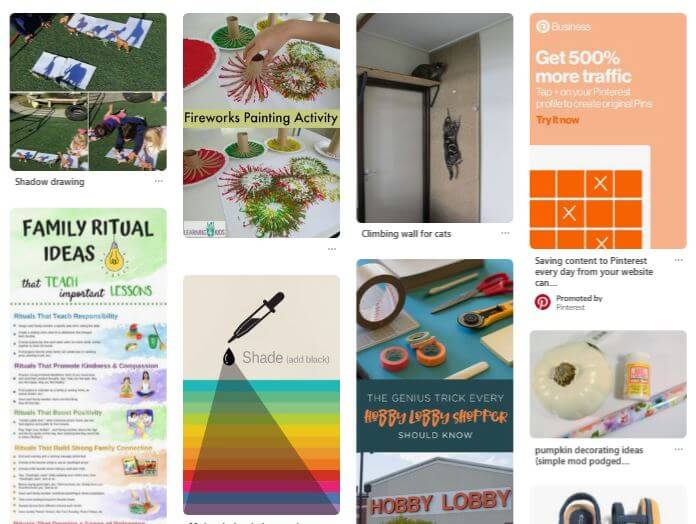
In this case, Pinterest is using its platform to advertise tips for businesses. It’s always encouraging to see a company using its own advertising services. That’s one way to know that the system works.
What Is Pinterest?
First, let’s discuss Pinterest and how it works. Some people say that Pinterest is a social network. Others refer to it as a search engine. Through Pinterest, you create a profile and then “pin” visual content onto different “boards.”
It’s like a collection of virtual bulletin boards. Instead of cutting out paper images from magazines, though, you save images that you find on the internet. You can write a description or include a link with those images so that you can refer back to the website from which they came.
You can create several boards and label them however you’d like. Most people set up boards for different categories. For example, you might have boards that are labeled:
- Home décor
- Fun summer activities
- Dessert recipes
- Knitting and crochet
- Boho style
If you’re looking for inspiration for a project, a shopping venture or content that falls in line with your interests, you can search for it on Pinterest. Your search results appear as visual pins with short descriptions underneath them. This is what came up when we searched for “watercolor tutorials”:

To find out more about each search result, you can click on it. From here, you can see the full description, the URL from which the image came, when it was published and any comments that other users have left.

Here’s where things get social. You can leave a comment or ask a question. You can also follow the original poster’s account. Therefore, simply pinning items that interest you can drive traffic back to your Pinterest page and potentially to your website.
Emarketer says that there are 2 billion monthly searches on Pinterest. The platform drives about 5 percent of referral traffic to websites.
When you log onto Pinterest, you’ll see your feed, which shows the pins that the platform thinks that you’ll be interested in. You might see pins from people you follow or a combination of content that you might care about, based on other items that you’ve pinned.
However, Pinterest prefers to show content from trusted sources in users’ feeds. Therefore, if you’re using Pinterest for your business without advertising, you need to make sure that you pin high-quality content and that your pins are receiving engagement in the form of click-throughs, saves and comments. Premium tools like Tailwind make this process much more efficient.
Why Pinterest Advertising Works
While Facebook is the largest social media platform, Pinterest is competitive with Instagram, LinkedIn, Reddit, and Twitter, according to Pew Research. Twenty-six percent of all American adults use Pinterest, and most of them are women. Pinterest reports that 40 percent of people who actively pin have a household income of at least $100K. If you sell products targeted toward women who want to shop, you’re in the right place.
Here are some other statistics about Pinterest users and their purchasing power:
- Millenials use Pinterest as much as Instagram.
- People who use Pinterest are ready to make a purchase.
- 93% of active pinners use the platform to plan future purchases.
- 73% of pinners say that brand content makes the platform more useful.
- 61% of pinners have bought something after viewing a promoted pin.
- 75% of saved pins are initiated by businesses.
- People who use Pinterest spend 29% more on retail than non-users.
People search the platform for information that they can use to fuel upcoming purchases for things like home renovations, weddings, parties, vacations or having a baby. This is the place where people are looking for new information, ideas and brands. If you can provide these new ideas, you can make connections with a new audience.
Pinterest advertising looks natural. It fits into place with the other pins in your feed, and it doesn’t detract from or interrupt the user experience. So, promoting your pins puts you in front of a receptive audience who is looking for products and ideas that will help them make their next move.
Types Of Pinterest Advertising
There are several types of Pinterest ads, including:
- Promoted pins
- Promoted video pins
- One-tap pins
- Promoted app pins
- Cinematic pins
Promoted pins look just like a regular pin, except that they have the word “Promoted” at the bottom of the pin. Businesses pay Pinterest to give these priority over non-promoted pins. Once someone saves your promoted pin, it’s considered an organic find, and that person will no longer see the word “Promoted.” Other people who follow these pinners may find and save these pins, bringing you added traffic for free.
If your promoted pin contains a video, it will appear in search results, news feeds and a “More Like This” section that comes up below a clicked pin and shows similar content. The video will play automatically.
One-tap pins bypass the close-up image and “more details” page that normally shows up when you click on a pin in your feed. When a user clicks on these ads, they go straight to a landing page that you designate. You might think that this is a great way to get your audience in your lap, but some users are surprised by the change in the normal process and click off of your website quickly to get back to Pinterest.
If you are promoting an app, you can use a promoted app ad to get people to install it. The ad will include an app icon and install button so that users don’t have to leave Pinterest to sign up for your app.
Cinematic pins contain animation that moves when a user scrolls. This captures users’ attention and makes them feel like they’re in control without missing the end of the video.
5 Things To Do Before Advertising On Pinterest
Paying to promote pins can be an effective marketing strategy. However, there are a few steps that you should take before you set up your first advertisement on Pinterest.
1. Register For A Business Account
If you haven’t used Pinterest before, you’ll need to create a new account. It’s free to set up, and it takes less than a minute. Start by going to Pinterest’s Business Account page and clicking “Sign Up.”
Enter your email address, password and business name, select your business category from the drop-down menu and click “Create account.”
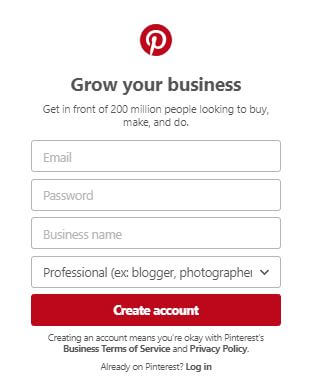
Follow the next steps, which are self-explanatory. These include selecting your language and country, adding your website URL and picking at least five categories in which you’re interested.
If you already have a Pinterest account, log in and click on Settings. It will say “Business Account Basics” on the top left if it’s a business account. If it’s a personal account, you can convert it to a business account by going to this link.
2. Claim Your Website
When you set up your business account, you should have added your business website URL to your profile. If you didn’t do that yet, go to your settings by clicking on the profile image on the top right when you’re logged into your account. Scroll down until you see the “Claim Website” section.
After you claim your website, you can utilize features such as:
- Website analytics – Track traffic to pins from your site.
- Featured logo – Add your profile picture to any content that’s pinned from your site.
- Early access to tools – Be the first to hear about new business tools that Pinterest rolls out.
To claim your website, you’ll need to either add a bit of code to the <head> section of your website’s index.html file or download a file from Pinterest and upload it to your site’s root directory. After you do that, you can submit your website to Pinterest for review.
3. Install A Conversion Tag
You can add another Pinterest code to every page that you want to track on your website. The code is the same for every page, but you can use it to retarget people who have visited specific pages on your website.
To do this, click on “Ads” on the top left of your account, and then select “Conversion Tracking.”
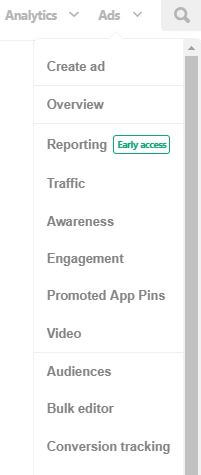
Choose “Generate Pinterest Tag.” You’ll get code that you can insert between the <head> and </head> elements in the HTML of every page on your website for which you want to track visitors.
4. Upload Your List
If you have amassed a list for your newsletter, you can upload it to Pinterest so that you can target the same users with your Pinterest ads**. Just create a .csv file with the email addresses that you’ve collected over the years. Log into your Pinterest account.
**If you go this route – you need to have your audience’s consent. If you are in the EU, it’s the law. If you are outside the EU, you want to be cool, not creepy.
Click on Ads > Audiences.

Then, click on “Create Audience.” Choose “A list of customers that you upload” from the window that appears. Name your audience, and include the date so that you can update it a few months from now.
Pinterest will match up the email addresses from your list with those of its users so that you can show ads to the same people. In the future, you can also create “an act-alike audience that behaves similarly to the one you already have.” This will choose people with similar demographics and interests as the people on your email list.
5. Pin Some Content
You can’t promote a pin unless you’ve pinned it publicly. Therefore, if you have created a new Pinterest account in hopes of setting up some ads, you should take some time to create boards and pin content for free before you put money into it.
Make sure that all of your pins contain high-quality images. The visuals are going to grab people’s attention before anything else. Therefore, they need to be top-notch.
You can do this manually, but there are a ton of amazing tools out there that can help you create really high-quality pins. Here’s a few tools –
- Stencil – quick, effective, browser-based.
- Canva – web-based, lots of options, team options.
- Tailor Brands – brandbook integration, auto-scheduler.
- TailWind – scheduler with formatting tool.
Vertical Pins
Pinterest displays images vertically. Therefore, you need to use the correct aspect ratio to get the most out of your pins’ appearance. For years, Pinterest has claimed that a 2:3 aspect ratio is ideal. However, some pinners said that posts with these dimensions didn’t perform well. Some people even created extra-long posts to capture people’s attention.
As of June 2018, however, Pinterest said that those “giraffe pins” may be cropped and won’t show up as frequently in people’s feeds. The ideal aspect ratio is 600 pixels wide by 900 pixels high (720 x 1080 works well too). Square images look good, and they are easy to import from Instagram.
An aspect ratio of 600 x 1260 (with 1260 being the height in pixels) won’t be cropped. Anything taller will.
If you’re creating long giraffe pins, make sure that they add value. Infographics and step-by-step tutorials are ideal for these space-hogging pins.
Rich Pins
Creating Rich Pins can help people learn more about your products. Rich pins contain additional information, including:
- App – Takes viewers to the app store for download
- Article – Includes a headline, author and story description
- Product – Includes pricing, availability and purchase location
- Recipe – Includes title, ingredients, cooking times, serving information and ratings
By adding the metadata directly to the pin, brands can increase engagement. Picture a recipe that contains a gorgeous picture of the food that you’re eating with the recipe itself below it. The pins pull from the metadata on your website.
Creating Rich Pins is a two-step process. First, you must add metadata to the articles, products, and recipes on your site. If you have a WordPress site, you can do this easily with a plugin like Yoast. Then, you need to verify your Rich Pins with Pinterest. Once you validate one URL with a Rich Pin on your site, you’re all set. You don’t need to validate all of the URLs with all Rich Pins.
Buyable Pins
Pinterest rolled out Buyable Pins in 2015 to make it easier for its audience to shop directly from a pin. These pins list the price in blue and contain a Buy It button so that people can make a purchase right from the app. When someone clicks Buy It, they go directly to the checkout, where they can pay with a credit card or Apple Pay.
If you’re a retailer or sell your own products, you’ll need to have a Shopify store that’s linked with the Pinterest sales channel to take advantage of Buyable Pins. As long as you point a pin’s URL to the product detail page on your Shopify store, it will activate as shoppable.
Pinterest automatically matches your product feed with your pins and generates Buyable Pins for any products that you have already pinned. For any other product, you should create pins from scratch. These can include additional images so that more people can discover your products.
Buyable Pins are similar to Rich Pins in that they display additional information. Rich Pins, however, don’t send you to the checkout when you click on them.
How To Set Up A Pinterest Ad
If you’ve decided to spend money on advertising, you might wonder how to advertise on Pinterest. This is a step-by-step tutorial that teaches you how to do it.
1. Create The Ad
When you’re ready to start advertising, click on the + sign that appears toward the top right, and then select “Create Ad.”
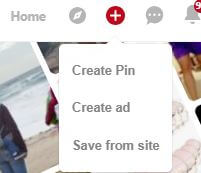
This brings you to your Ads Manager, where you can create your campaign.
2. Set Your Goals
You’ll begin by selecting your campaign objective.

Then, you’ll enter your campaign details. You’ll have to come up with a name for your campaign if it’s new, or you can select an existing campaign from the drop-down menu. You’ll also designate your daily and lifetime budget for the campaign here.

Then, decide on your campaign placement, which includes whether you want to make your ads one-tap. This feature can’t be edited once your campaign starts running.

If you’re creating an app install ad, you will have the option to select whether to optimize the campaign for completed installs or visits to the app download page. Both are charged on a cost-per-click basis. Pinterest also has direct integrations with mobile measurement partners, or MMPs, which help you track the install performance.

Finally, click “Create campaign and continue.”
3. Set Up An Ad Group
An ad group is a set of promoted pins that fall under the same campaign. You can have multiple ad groups for one campaign, which means that you will have a separate budget for your ad groups than you do for the campaign as a whole.
Understanding Ad Groups
Each ad group can have multiple promoted pins within it. You can assign different budgets and targets to each ad group, though. Therefore, you can use ad groups to set up unique budgets for different marketing areas, such as regions, demographics or products. You can also use ad groups to test the design, placement, and objectives of your advertisements without building separate campaigns.
For example, you could create separate ad groups with maximum daily budgets to target:
- Your email list
- People who have visited related pages on your website
- Act-alike audiences
To keep everything straight, you should name your ad group based on its organizational structure, such as who you’re targeting or what promoted pins are showing up within that group.

4. Create A Target Audience
On the ad group page, you’ll be asked to create a target audience. This helps you get your ads in front of the right people. You can target viewers based on the following criteria:

You’ll need to give this audience a name and description. If you choose to retarget people who have visited your website, you’ll have to create a Pinterest tag to track them. If you choose to target individuals from an email list, you’ll be asked to upload the list.
You’ll be able to further clarify your audience by interests, such as boards and pins that they’ve interacted with in the past, keywords, languages, locations, devices, and genders.
5. Create Your Maximum CPC Bid
On the page where you create your ad group, you’ll be asked to set a maximum CPC bid. This is the maximum amount that you want to pay per audience action, whether that’s impressions, clicks, engagement or app download. You won’t be charged the full bid unless it’s necessary to beat out the next-highest bidder.
6. Select Your Promoted Pin
Now, you can select the pin that you want to promote. You can only choose from items that you’ve publicly pinned. The pin doesn’t have to be one that you have initiated through your own website, although it would probably be a good idea to use an image that you’ve created.

Next, you’ll give the promoted pin a name (optional) and set the URL of the landing page that you want visitors to end up on when they click on it.
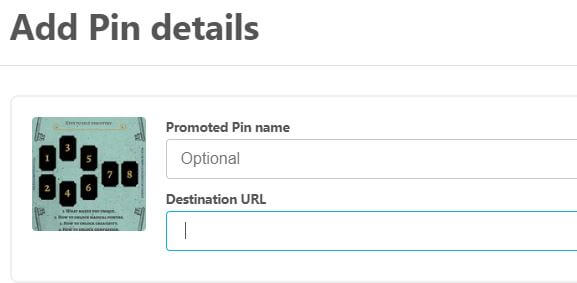
Consider the URL carefully. Ideally, you’ll send people who click on your ad to a page dedicated to your Pinterest audience. The landing page should have something to do with the pin that led people to it. If you’ve added Pinterest tag code to your website, you’ll be able to track the success of each promoted pin.
Click “Promote Pin” when you’re finished. The ad will go to Pinterest for review, which can take 24 hours. At this time, add your billing details so that you can pay for your ad once it’s approved.
The Quick Way To Promote A Pin
Pinterest also provides a way to promote your pins in about 10 seconds. Go to your profile and hover over a pin that you want to advertise. Click on the Promote button.
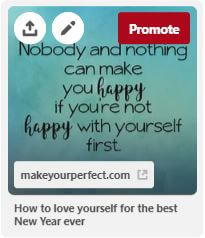
A window will open up where you can add all of the promotional details, including the URL, daily budget, campaign duration, target audience, and keywords.
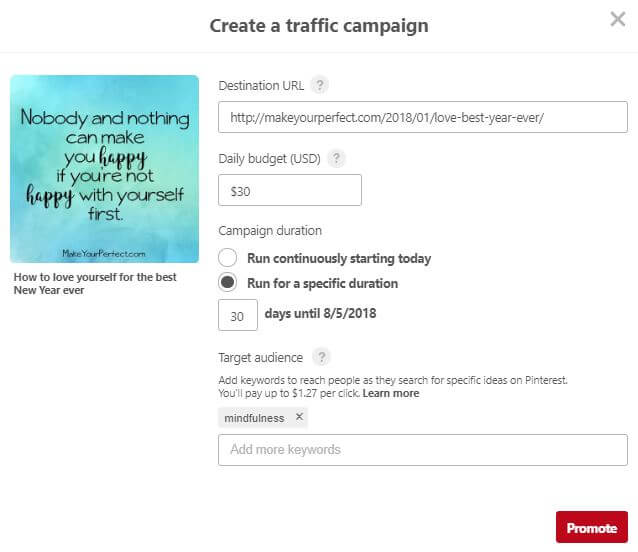
Tips And Tricks For Optimizing Your Pinterest Advertising
Just putting yourself out there isn’t always enough to gain an audience. Instead of wasting your dollars by advertising blindly, follow this advice to get the most out of your budget.
Promote The Best Pins
You might wonder what pins to promote when you advertise on Pinterest. Those with strong visuals do best. Making multiple pins for the same product is a good idea. You can show different angles, styles, and descriptions to pull in different customers. Adding your brand name or logo to the image improves credibility.
If you sell products, Pinterest says that photographing them in lifestyle shots is more effective than displaying the product on its own. For example, a fashion pin should show someone wearing the clothing in a real-world setting. Home décor pins do better when they concentrate on the product instead of people. Hair and beauty products get great engagement when the items are displayed against a plain, contrasting background.
Most experts recommend promoting pins that are already doing well. Even though you might figure that boosting a low-performing pin could help it get in front of your audience, promoting a high-performing pin is more likely to give you results. Wouldn’t you want to pay for results as opposed to a lackluster reception to your ad?
When you’re picking a pin in step 3 of the ad creation process, you have the option of choosing from all pins, 30-day most clicked pins or 30-day most saved pins. Use this to your advantage to promote your most engaging content.

Add Text To Your Pins
Even though Pinterest relies on photos, it doesn’t hurt to add a little text to your images. The text overlay should clarify what viewers are looking at without detracting from the design as a whole. The words shouldn’t detract from the aesthetic. A simple overlay works wonderfully.
Make sure that you’re using the description wisely too. A call-to-action helps users stay engaged. You can ask people a question or give an instruction, such as “Learn more” or “Buy now.” You might even try having your call-to-action say, “Pin this for later” to remove the urgent sales quality but encourage people to save your pin.
Consistently Monitor And Analyze Your Ads
It’s hard to predict what’s going to resonate with viewers. Pinterest is a visual platform, and some images may capture more attention than others. When you’re just starting out, test everything, including the:
- Image
- Description
- Call-to-action
- Keywords
- Bids
- Audiences
After doing this consistently for a while, you’ll begin to notice which combinations are more effective.
Focus Your Keywords
Although you’re allowed to include up to 150 keywords with a promoted pin, you don’t have to use all of them. If you’re all over the place, you won’t get many click-throughs. Think about the way that your audience interacts with Pinterest.
The keywords should match the way that your target audience uses the platform (similar to how you “theme” keywords for SEO). Make sure that the keywords are also consistent with the information in the pin and the landing page to which they’re directed.
Because Pinterest is a search engine, keywords are crucial to your pins’ visibility. Create your descriptions the way that you would create meta tags for a web page’s title and description. Using trending keywords earlier in the text will help your pins get noticed.
When you place pinnable images on your website, make sure that you include keywords in the alt text. Your boards should contain long-tail keywords. Use Pinterest Analytics to track which pins get the most impressions and experiment with the keywords that you use.
Add Value
The best practices for advertising on some other platforms involve using a call-to-action to send people to a lead page. However, people who search using Pinterest are looking for information. They might get annoyed if they come across your promoted pin, click on it to investigate it further and reach a page that simply asks them for their email address.
An effective way to use Pinterest for advertising is to send people to a landing page where they can explore what you offer. You can certainly include a lead generation form on this page, but don’t make it the only asset at that URL.
Group Boards
Group boards are sometimes referred to as shared, community, collaborative or contributor boards. Using them can lead to significant increases in traffic.
More than one person can add pins to a group board. Therefore, when anyone adds pins to the board, those pins may appear in the home feed of anyone who follows any of the board members. This exponentially increases your reach.
If you focus on sharing your own content to group boards, you’ll gain exposure for your brand. Keep the content relevant, however.
Since Pinterest rewards high-quality pins with exposure, make sure that you join the right group boards. Those that are targeted to a specific theme usually have more traction with an audience and get more engagement. Click on several of the pins on a group board that you’re thinking of joining to make sure that the links aren’t broken or redirect to a spammy or inappropriate site.
Pinterest is an opportune way to expose your brand to a new audience. The platform isn’t just used by crafty people, DIY-ers and foodies. Travel, fashion, design, hobbies, health and beauty, entertainment, accessories and sporting goods are commonly searched categories on Pinterest. Creating a business account for your brand is free, and you can play around with promoting your pins at a low cost to determine whether it works well for your business.
Next Steps
Pinterest holds a lot of opportunity for businesses of all sizes. It’s also straightforward and fairly risk-less to experiment there.
You’ll learn more from running a single experiment than any blog post – so go for it!
If you want to know other ways to use Pinterest for marketing, check out Nate’s post on Pinterest & SEO research in addition to Using Pinterest Analytics.
Read my post on how to advertise your website online for other ideas!



